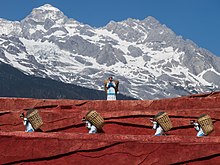This article needs additional citations for verification. (April 2009) |
 Nakhi people in a staged basket-carrying performance | |
| Total population | |
|---|---|
| 326,000 | |
| Regions with significant populations | |
| China (Sichuan, Yunnan) | |
| Languages | |
| Nakhi | |
| Religion | |
| Dongba, Tibetan Buddhism, Taoism | |
| Related ethnic groups | |
| Mosuo |
The Nakhi, Nashi, or Naxi (simplified Chinese: 纳西族; traditional Chinese: 納西族; pinyin: Nàxī zú; Naxi: Naqxi) are a people inhabiting the Hengduan Mountains abutting the Eastern Himalayas in the northwestern part of Yunnan Province, as well as the southwestern part of Sichuan Province in China.[1]
The Nakhi are thought to have come originally from northwestern China, migrating south toward Tibetan-populated regions, and usually inhabiting the most fertile riverside land, driving the other competing tribes farther up the hillsides onto less fertile land. The Nakhi traded over the dangerous overland trading links with Lhasa and India, on the so-called tea and horse caravan routes.
The Nakhi form one of the 56 ethnic groups officially recognized by the People's Republic of China. The official Chinese government classification includes the Mosuo as part of the Nakhi people.
Nakhi culture is largely its own native Dongba religious, literary, and farming practices, influenced by the Confucian roots of Han Chinese history. Especially in the case of their musical scores, it acts as the foundation of the Nakhi literature. The Nakhi have their own writing, their own distinct language and their own native dress.